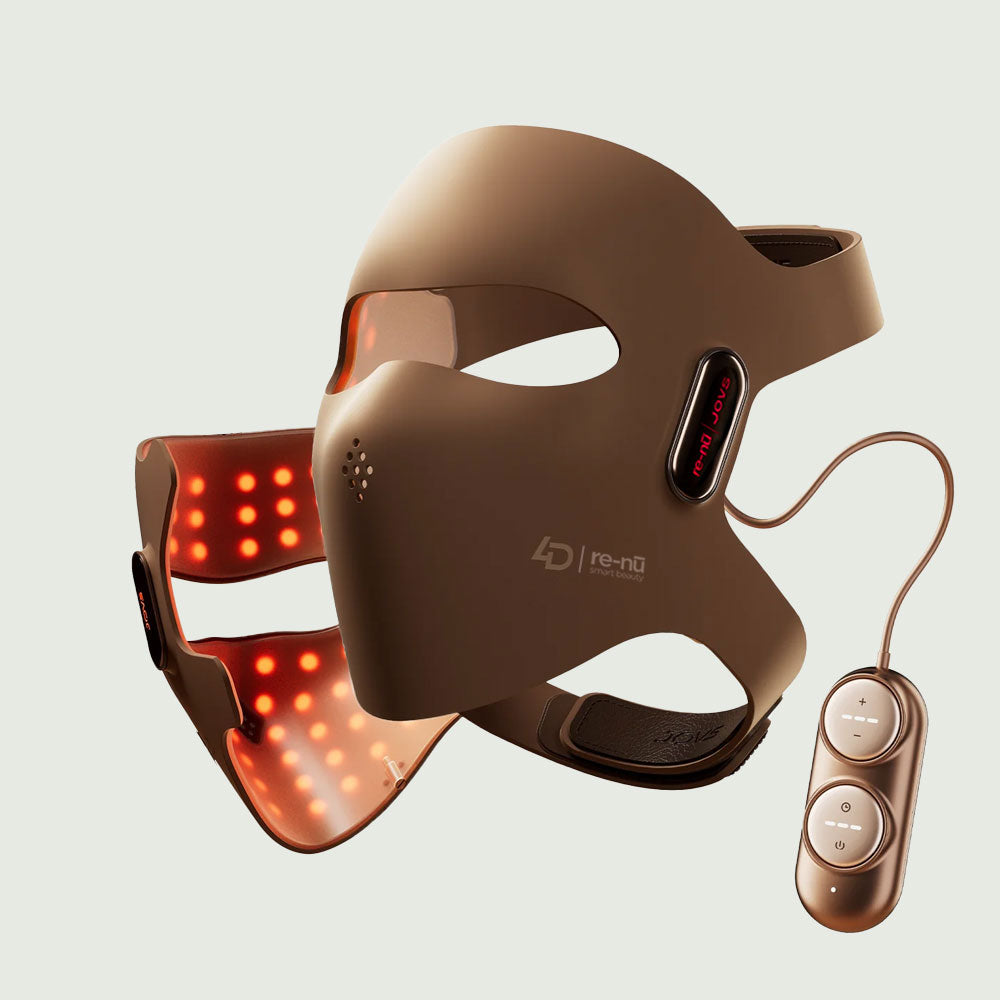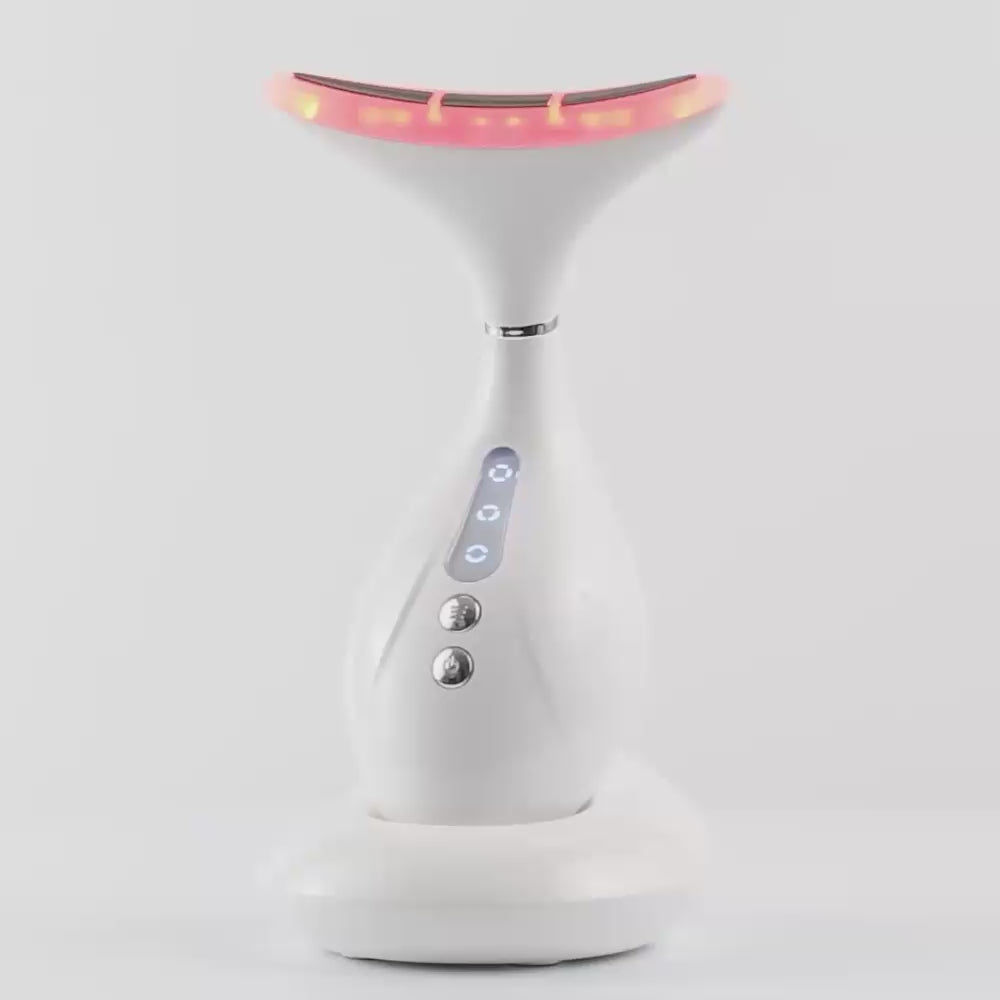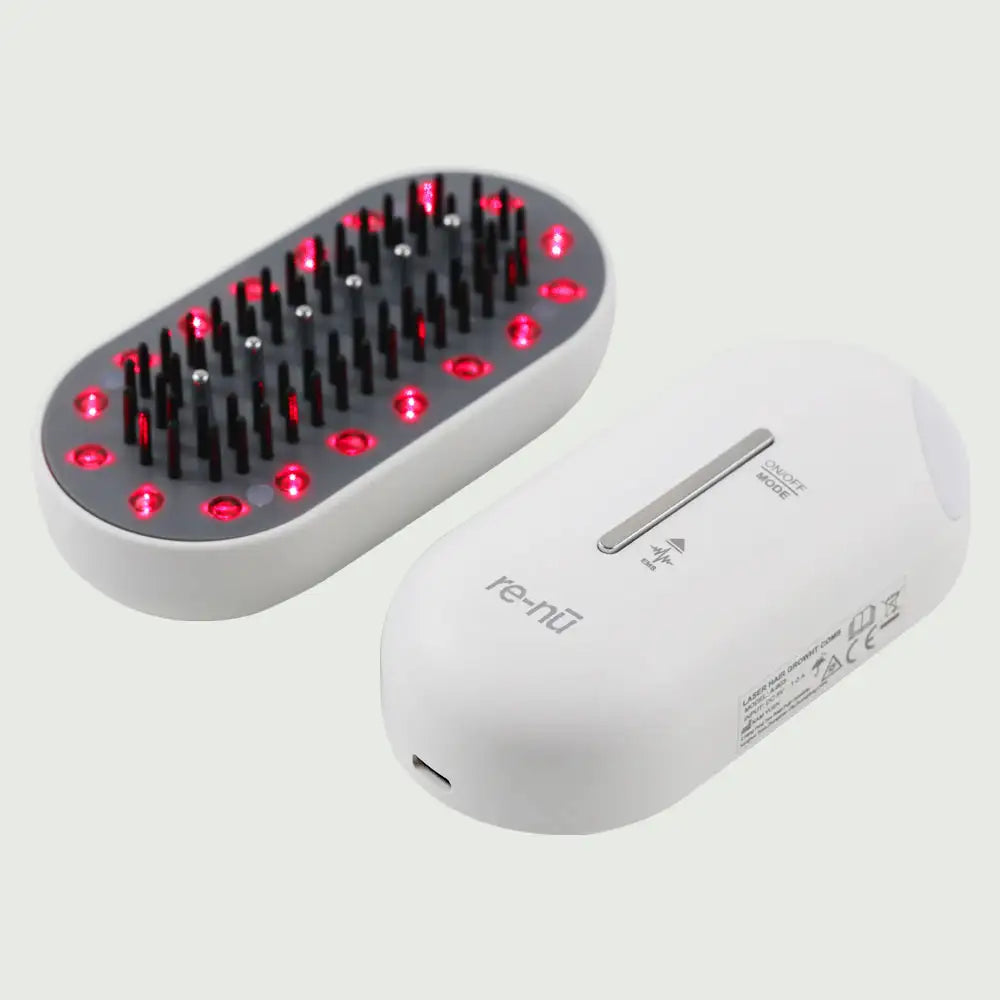Smart Beauty Insights
Explore expert blogs on red light therapy, skincare innovations, and beauty tech to elevate your routine with confidence.
LED Light Therapy for Acne at Home: Does It Really Work?
Acne affects millions of people worldwide, and in 2025, skincare technology offers more effective solutions than ever before. One of the fastest-growing treatments is LED light therapy for acne, a non-invasive, painless, and scientifically backed method to target blemishes, inflammation, and uneven skin tone. But does it really work, and can you get professional-level results at home? This guide will give you everything you need to know about LED light therapy for acne at home, how it works, its benefits, and the best way to incorporate it into your skincare routine. We’ll also explore the Red Light Therapy Torch – Skin Renewal & Radiance by re‑nū Smart Beauty, a cutting-edge device designed for precision acne treatment. What Is LED Light Therapy? LED (Light-Emitting Diode) therapy uses specific wavelengths of light to penetrate the skin and trigger biological processes. Unlike UV rays, which can damage skin, LED light is non-invasive and safe for regular use. For acne treatment, the most effective wavelengths are: Blue light (400-500nm): Kills acne-causing bacteria (P. acnes) at the skin's surface.Red light (630–660nm): Reduces inflammation, calms redness, and promotes healing.Near-infrared light (850nm): Penetrates deeper layers to support repair and reduce scarring. By combining these wavelengths, modern LED devices target both the causes and symptoms of acne. How Does LED Light Therapy Fight Acne? LED therapy addresses acne in three main ways: Eliminating Bacteria Blue light penetrates pores and destroys P. acnes bacteria, preventing future breakouts. Reducing Inflammation Red light calms inflamed skin, reducing redness and swelling. Supporting Healing and RepairNear-infrared light stimulates collagen production, helping skin heal faster and reducing the appearance of acne scars. Consistent use leads to clearer, healthier skin over time, without the side effects associated with harsh treatments or medications. Can You Really Do LED Light Therapy for Acne at Home? Absolutely. At-home devices have advanced dramatically, offering professional-grade results in compact, user-friendly designs. They allow you to: Treat acne without expensive clinic visits. Target specific areas great for stubborn spots or sensitive skin. Use therapy as part of your regular skincare routine, anywhere and anytime. Devices like the Red Light Therapy Torch are portable, powerful, and designed for precision treatments, making at-home care simple and effective. Why Choose the Red Light Therapy Torch? The re‑nū Red Light Therapy Torch stands out in 2025 for its tri-spectrum technology and ergonomic design: 3-in-1 Therapy Modes: Combines red, near-infrared, and blue light for a complete acne solution. Precision Fiber Optic Tip: Targets blemishes, scars, and problem areas with pinpoint accuracy. Eight Custom Modes: Adjustable intensity and pulsing settings for your specific skin needs. Compact & Rechargeable: Perfect for at-home use, travel, or on-the-go skincare. Whether you’re fighting occasional breakouts or persistent acne, this device provides a targeted, non-invasive solution. How to Use LED Light Therapy Torch for Acne at Home Here’s a simple routine to get the most from your device: Cleanse Your Skin Use a gentle, non-comedogenic cleanser to remove oil and dirt. Choose Your ModeSelect blue light for active breakouts, red for inflammation, or combined modes for comprehensive care. Target Problem AreasHold the torch with the fiber optic tip 1–2 cm from the blemish or affected area. Treat each area for 2–3 minutes. Follow with SkincareApply a lightweight serum or moisturizer to soothe the skin. Stay ConsistentUse 3–5 times a week for best results. Many users notice clearer skin within 2–4 weeks. Benefits of LED Light Therapy for Acne Non-invasive & Painless: No downtime or discomfort.Kills Acne Bacteria: Prevents breakouts at the source.Reduces Redness & Swelling: Promotes a calmer, clearer complexion.Supports Healing: Helps fade acne scars and improve texture.Safe for All Skin Types: Gentle and effective without irritation.Convenient: Use anytime, anywhere with a portable device.Cost-Effective: Avoid expensive clinic treatments. Tips for Best Results Stay consistent, LED therapy works gradually with regular use.Use on clean skin to allow light to penetrate effectively.Combine with a gentle skincare routine, avoid harsh exfoliants on treated areas.Be patient, expect noticeable improvement after a few weeks.Protect your skin with sunscreen daily, as healed skin may be sensitive to UV rays. Are There Any Side Effects? LED therapy is widely regarded as safe, with no UV exposure or downtime. Mild warmth or temporary redness may occur but typically subsides quickly. Avoid using the device on broken skin, active infections, or if you have photosensitivity. Who Should Consider LED Light Therapy for Acne? Those with mild to moderate acne.People seeking non-invasive, drug-free treatments.Anyone looking to reduce redness, swelling, or acne scars.Busy individuals who want quick, at-home treatments. FAQs About LED Light Therapy for Acne at Home Q1: How soon will I see results? Most users see improvements within 2–4 weeks of consistent use. Q2: Can I use it with other acne treatments? Yes, it works well alongside most skincare products. Avoid using harsh chemical peels immediately before or after. Q3: Is it safe for sensitive skin? Yes, LED therapy is gentle and suitable for all skin types. Q4: Does LED therapy work on acne scars? Red and near-infrared light help stimulate collagen, reducing the appearance of scars over time. Q5: How long should each session last? Typically, 2–3 minutes per area, 3–5 times a week, is recommended. Final Thoughts: Clearer Skin, Made Simple LED light therapy has revolutionized at-home acne treatment. Backed by research and loved by skincare experts, it provides a safe, effective, and convenient way to achieve clearer skin. If you’re ready to experience the benefits, explore the Red Light Therapy Torch – Skin Renewal & Radiance by re‑nū Smart Beauty. Its advanced technology, precision design, and portability make it one of the best at-home LED light therapy solutions for acne in 2025.
Learn moreHow Blue Light Therapy Treats Acne and Who Should Try It
Breakouts aren’t just skin deep, they affect your confidence, mood, and how you show up in the world. But what if the solution didn’t come from a pill or a cream, but from light itself? That’s where blue light therapy steps in: a dermatologist-approved, non-invasive treatment that targets acne-causing bacteria without touching or irritating the skin. Using specific wavelengths of LED light, it penetrates the skin’s surface to eliminate P. acnes bacteria, the root cause of many breakouts, while calming inflammation and preventing future flare-ups. Thanks to recent innovation, blue light therapy is no longer limited to dermatology clinics. Today, compact and affordable at-home devices bring the same technology to your fingertips, offering a safe, effective, and chemical-free option for treating acne. So how does it really work? Who should use it? And what results can you expect? This guide breaks down the science, benefits, best practices, and important safety tips so you can decide if blue light therapy is right for your skin. The Science Behind Blue Light Acne Therapy Blue light therapy isn’t just a trend, it’s a clinically backed treatment that tackles acne at its source. It works by using a precise wavelength of light, usually around 415 nanometers, to penetrate the upper layers of your skin and destroy Propionibacterium acnes (P. acnes), the bacteria that fuels most inflammatory acne. What Blue Light Does: Kills acne-causing bacteria deep within the sebaceous glandsReduces redness and inflammation, helping blemishes heal fasterHelps regulate oil production over time, preventing future breakoutsImproves skin clarity without harsh ingredients, scrubs, or drying agents Multiple clinical studies show that with consistent use, typically a few times a week for 4 to 12 weeks, blue light therapy can reduce moderate acne lesions by up to 70%, making it a powerful, drug-free alternative to traditional treatments. How At-Home Blue Light Devices Work You no longer need to book a dermatologist appointment to get professional-grade treatment. Thanks to advances in skincare tech, FDA-cleared at-home blue light devices bring the same acne-fighting power straight to your bathroom counter.These handheld or mask-style tools emit targeted blue light that treats the skin in short daily or weekly sessions, often as little as 5 to 10 minutes per treatment. They’re safe, painless, and designed for regular use, making it easier than ever to stay consistent without disrupting your routine.Whether you’re dealing with occasional breakouts or long-term acne, these devices allow you to treat flare-ups quickly and effectively, without prescriptions, downtime, or side effects. How to Use Blue Light Therapy for Acne: Step-by-Step Guide Using blue light therapy at home can be a simple and effective part of your skincare routine. To get the best results, it is important to follow each step carefully and consistently. Here is how to use it properly for clearer, healthier skin. Step 1: Begin with a Thorough Cleanse Wash your face with a gentle, non-comedogenic cleanser to remove any makeup, oil, or dirt. This ensures your skin is clean and prepped so the light can penetrate effectively. Step 2: Prepare and Activate Your Device Turn on your blue light therapy device and select the appropriate setting. Make sure it is fully charged or connected to power. Read the instructions provided with your device for specific guidance. Step 3: Treat Acne-Prone Areas Hold the device directly over the affected areas or slowly glide it across your skin. Focus on one area at a time, treating each section for about two to five minutes depending on the severity of the acne and the device recommendations. Step 4: Stay Consistent with Treatment Use the device once a day or as instructed by the manufacturer. Most people start to see noticeable improvements in their skin within four to six weeks of consistent use. Step 5: Moisturise and Protect After your session, apply a lightweight, oil-free moisturiser to soothe and hydrate the skin. If you are using blue light in the morning, follow with a broad-spectrum sunscreen to protect your skin barrier throughout the day. For best results, avoid applying strong active ingredients like retinol or chemical exfoliants immediately before or after using blue light. Stick to a simple, calming routine to let the therapy work effectively. Key Benefits of Blue Light Therapy for Breakouts Blue light therapy offers more than just acne reduction, it provides a safe, science-backed approach to improving overall skin health without the harsh side effects of traditional treatments. Here’s why more people are turning to this innovative technology: Non-invasive and Chemical-Free Blue light targets acne at its source without breaking the skin or introducing any harsh chemicals. It is a gentle option, especially for those with sensitive or reactive skin. No Downtime, No Recovery Unlike some acne treatments that cause peeling, redness, or irritation, blue light therapy is completely painless and requires no downtime. You can get on with your day immediately after use. Calms Inflammation and Reduces Active Breakouts The light penetrates the skin to destroy acne-causing bacteria and calm inflammation, helping existing breakouts heal faster while preventing new ones from forming. Suitable for All Skin Tones Because blue light does not rely on heat or pigmentation, it is considered safe and effective across all skin tones and types. Compatible with Topical Skincare You can safely use blue light alongside your favourite non-irritating serums, cleansers, and moisturisers. It complements other acne treatments, rather than replacing them. Convenient At-Home Use Today’s portable, user-friendly devices make it easy to stay consistent. With just a few minutes a day, you can maintain clear skin from the comfort of your home. Improves Skin Clarity and Texture Beyond treating breakouts, regular use can leave your skin looking smoother, clearer, and more even in tone over time. Who Should Try Blue Light Therapy? Blue light therapy is a smart, science-backed option for those seeking clearer skin without relying on harsh chemicals or prescriptions. It is especially beneficial for people dealing with persistent, mild to moderate breakouts that affect their confidence and skin health. This treatment is ideal for: Women, men, and teens with mild to moderate acne If you experience regular breakouts but want to avoid aggressive treatments, blue light therapy offers a gentle yet effective alternative. Anyone with hormonal acne or mask-related breakouts Whether your acne flares up due to monthly cycles, stress, or wearing masks daily, blue light helps reduce inflammation and bacteria buildup. People looking for a drug-free solution If you prefer to avoid antibiotics, strong acids, or prescription medications, blue light therapy delivers results without altering your skin’s natural balance. Those dealing with redness and inflammation Blue light is not just antibacterial, it also soothes irritated skin, helping to reduce visible redness and calm active breakouts. Users who want to complement their current skincare routine This therapy works well alongside non-irritating cleansers, serums, and moisturisers, making it easy to integrate into your current regimen. What Results Can You Expect? With consistent use (5 days a week): Week 2: Redness begins to calm Week 4: Fewer active pimples, smoother texture Week 6–8: Significant reduction in breakouts, clearer pores Combine with a simple, soothing skincare routine for best results. FAQs: Does blue light therapy actually help acne? Yes. Blue light penetrates the skin and kills acne-causing bacteria without damaging healthy tissue. How long does blue light take to clear acne? Results vary but most users see clearer skin in 4 to 8 weeks with regular use. What are the downsides of blue light therapy? Mild dryness or temporary redness in sensitive skin. Overuse may cause irritation. What wavelength of blue light is best for acne? Around 415nm is the clinical standard for acne reduction. What are the side effects of blue light for acne? Minimal. Potential temporary dryness, redness, or mild sensitivity. What is the FDA-approved blue light? FDA-cleared devices emit specific acne-targeting wavelengths and meet safety standards. Renusmart’s products use clinically safe blue light ranges. Who should avoid light therapy? People with photosensitive conditions, using retinoids, or taking meds that increase sun sensitivity. What should I put on my face after blue light treatment? Use a gentle moisturizer and broad-spectrum SPF if going outdoors. Final Thoughts: A Light-Filled Path to Clearer Skin If you're tired of harsh creams, endless product trials, or medications that don’t deliver, blue light therapy offers a smarter, skin-friendly alternative. Backed by science and trusted by dermatologists, this non-invasive treatment gets to the root of acne, killing bacteria, calming inflammation, and supporting clearer skin from the inside out. Whether you face occasional hormonal flare-ups or frequent breakouts, blue light therapy puts the power of professional skincare in your hands, but literally. With just a few minutes of consistent use each day, you can take control of your skin health without compromising its natural balance. Embrace this light-powered solution as part of your daily routine, and start seeing visible results, calmer skin, fewer breakouts, and renewed confidence. Sources https://www.medicalnewstoday.com/articles/319254 https://www.healthline.com/health/skin/light-therapy-for-acne https://dermnetnz.org/topics/blue-light-acne-treatment-acne-treatment
Learn more






